Small Florida Palm Trees (With Pictures) – Identification Guide
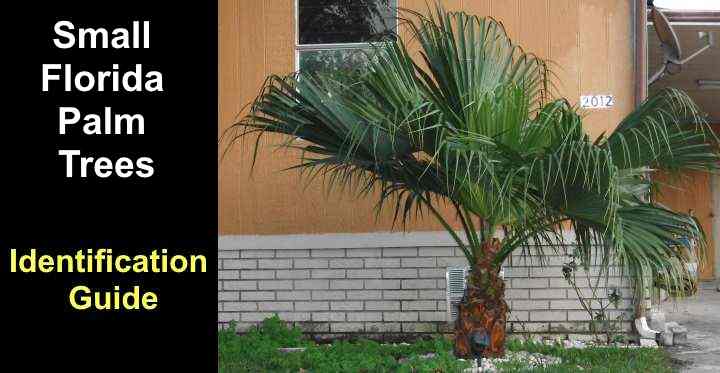
Small palm trees in Florida are the perfect solution to add a tropical twist to a southern garden landscape. Several species of dwarf palms don’t grow more than 20 feet (6 m). Popular small Florida palms include the Florida thatch palm, bottle palm, dwarf sugar palm, and Everglades palm. Additionally, many native low-growing Florida palms are easy to care for and thrive in the challenging climate of the Sunshine State.
Florida is known for its tropical beaches lined with tall palm trees. However, growing tall palms in Florida may not be the ideal landscaping solution for a front or backyard. Instead, small or dwarf palms are suitable for compact yards with limited space.
This article examines the features of small and dwarf palm trees that thrive in Florida. Additionally, each small palm tree is accompanied by a picture and a brief description of its identifying features.
Small Florida Palm Tree Facts
Palm trees and Florida go hand-in-hand. The Sunshine State is home to many native palms, many of which grow under 20 ft. (6 m) tall.
For example, the slender Florida thatch palm is slow-growing and maxes out around 20 ft. (6 m) tall. Or the stunning bottle palm only grows 12 to 15 ft. (3.6 – 4.5 m) tall. Also popular in Florida is the dwarf palmetto, whose fan leaves only reach 4 to 6 ft. (1.2 – 1.8 m) in height.
Small palms are perfect for landscaping gardens in Florida. Their tropical feathery fronds or fan-shaped leaves add aesthetic value and boost curb appeal. Additionally, their compact size makes dwarf palms ideal for planting in containers if yard space is restricted.
Small Florida Palm Tree Identification
Identifying small palm trees in the Sunshine State is possible by looking at the leaf shape, size, type of trunk, and crown shape. All palm trees—large or small—have either feather fronds or fan fronds. Also, Palm trees usually have a smooth gray trunk or a rough trunk with diamond-like protrusions where dead fronds have dropped off.
Another identifying feature of some small Florida palms is the fruits. Palm fruits can be bunches of dates or other soft fruits, many of which are edible. Although coconuts grow on palm trees, they only grow one species of palm—Cocos nucifera—a tall, majestic palm tree.
Types of Small Florida Palm Trees (With Pictures) – Identification Guide
Suppose you’re looking to add tropical appeal to your Florida home. In that case, the perfect way to turn your yard into a tropical paradise is to plant dwarf or small Florida palm trees. Not only do they provide shade and beauty, but there’s an array of low-growing palms to choose from, depending on your needs.
Whether you are looking for a small palm tree with feathery pinnate fronds for shade or a low-growing palm with palmate fan-shaped leaves for ground cover, this article has a palm tree for you.
Florida Thatch Palm (Thrinax radiata)
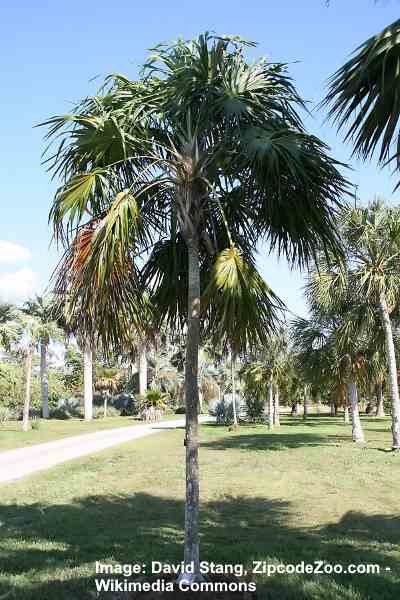
Florida thatch palm is grown in South Florida and is identified by its skinny smooth trunk and small size
The Florida thatch palm is a small, slow-growing native tree with a slender, solitary, smooth trunk and bushy crown. This native Florida palm grows 10 to 20 ft. (3 – 6 m) tall. Its crown comprises 12 to 20 large palmate fronds measuring 3 ft. (1 m) wide and growing on long, slender petioles.
The sun-loving Florida thatch palm can give your yard a distinctively tropical feel. These cold-sensitive palms thrive in South Florida, south of Fort Myers and West Palm Beach. In the right conditions, the small palm produces bunches of fruits throughout the year.
Bottle Palm (Hyophorbe lagenicaulis)
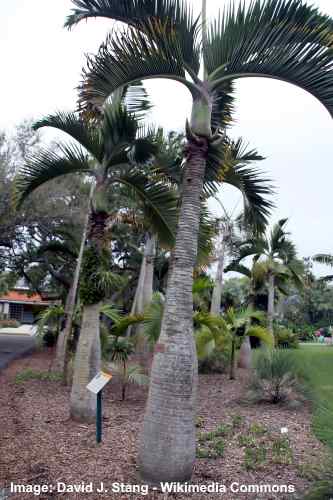
The small ornamental bottle palm tree has a thick short trunk
Bottle palm is an unusual ornamental small palm that loves full sun and warm temperatures. Ideal for South Florida landscapes, this small palm tree has a stout, bottle-shaped trunk and long, arching, feathery fronds creating a sparse crown. The bottle palm can grow up to 12 to 15 ft. (3.6 – 4.5 m) tall.
The distinctive feature of the small bottle palm is the swollen trunk at its base. Being sun, drought, and salt tolerant, it’s a perfect landscaping plant for coastal regions of Florida. The bottle palm is also perfect for planting in small gardens or containers on patios or decks.
The bottle palm is suitable for growing in USDA zones 10 and 11.
Cat Palm (Chamaedorea cataractarum)
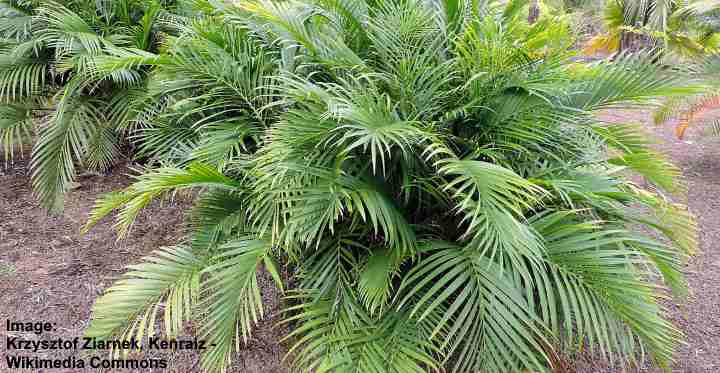
The dwarf cat palm is a great addition for a small Florida garden and can be also grown in a pot
The cat palm is a tropical, sun-loving plant with a compact growth habit. The palm tree grows up to 6 ft. (1.8 m) tall and 8 ft. (2.6 m) wide. Its distinctive feature is its feathery fronds arching gracefully on slender stems directly from the ground. The fronds are bright green and measure up to 3 ft. (1 m) long.
Cat palms, with their bushy, low-growing foliage, are suitable for growing as a privacy hedge or screen in Central and South Florida. They are also suitable for growing in containers, enhancing the appearance of a patio or decking area with a touch of tropical greenery.
Cat palms are suitable for growing in USDA zones 9 through 11.
Christmas Palm (Adonidia merrillii)

The small Christmas palm tree is a popular choice to landscape compact Florida yards
The Christmas palm is a small Florida palm tree with a solitary trunk and stiff, arching pinnate fronds. This evergreen palm grows quickly up to 6 ft. (1.8 m) tall before slowing down as it matures to around 25 ft. (7.6 m) tall. The long, arching leaves measure 4 to 5 ft. (1.2 – 1.5 m).
The Christmas palm gets its name from its bright red fruits, which ripen in late December. Additionally, the palm blooms with clusters of cream-colored flowers. The low-maintenance palm tree is suitable as a specimen tree in small residential landscapes.
Dwarf Sugar Palm (Arenga engleri)
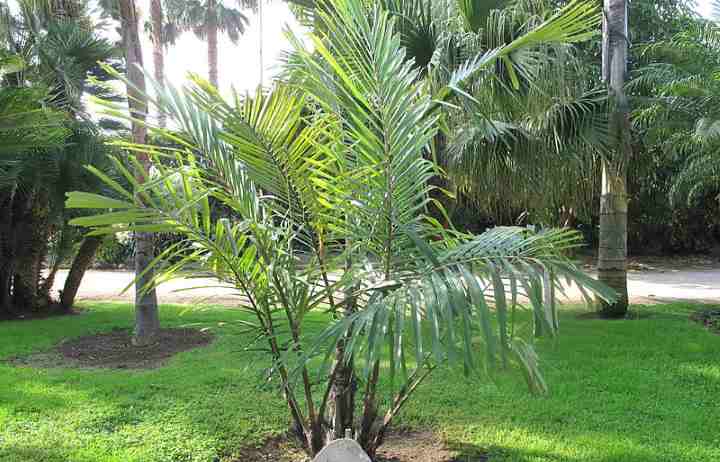
The dwarf sugar palm adds a decorative touch to a small front yard or backyard in Florida
The dwarf sugar palm is a sun-loving tropical palm tree perfect for small gardens from North Florida to the Florida Keys. This bushy palm tree has a compact growth habit, with pinnate leaves growing up to 8 ft. (2.4 m) tall. Sweet-smelling pea-shaped green, orange, or red flowers grow in bunches, followed by black fruits.
Dwarf sugar palm plants grow in clumps like clumping bamboo. The palm tree needs to grow in moist soils and is intolerant to drought.
Dwarf sugar palm is suitable for planting in some areas of USDA zone 8 but performs best in zones 9 through 11.
Bamboo Palm (Chamaedorea elegans)
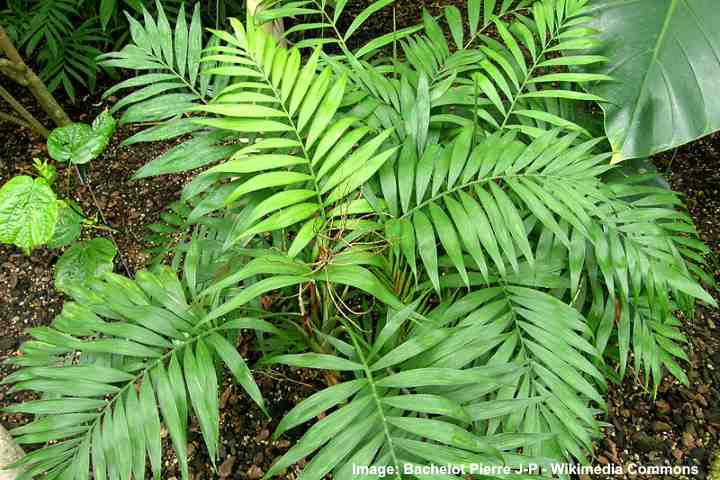
The dwarf bamboo palm is a shade-loving tropical tree that is suitable for south Florida
Also known as the parlor palm, the bamboo palm is a tropical outdoor plant that thrives in the shade. This palm is easily recognizable due to its slender, bamboo-like stems and glossy green fronds that create a lush, tropical feel. The small palm tree grows 6 to 9 ft. (1.8 – 2.7 m) tall.
Bamboo palm thrives in partial to full shade. The stems produce three to ten pinnate leaves, yellow or orange-red flowers, and sometimes pea-sized berries. This tropical palm thrives in USDA zones 10 to 12 as long as it’s kept out of direct sunlight.
The most common use of the parlor palm is to grow it in containers indoors. Thanks to its adaptability and tolerance for shade, this palm is one of the most popular indoor plants in the world.
Lady Palm (Rhapis excelsa)

The lady palm is a multi stem small tree that you can grow outdoors in central and south Florida
The lady palm is a slow-growing, shade-loving ornamental plant with fan leaves growing on bamboo-like canes. The bright green palmate leaves are 20” (50 cm) long and have up to ten narrow oblong lobes. This hardy evergreen palm plant grows in large clumps 6 to 5 ft. (1.8 – 4.5 m) tall.
The lady palm is a popular indoor plant that thrives in shady outdoor spots. The plant can be grown as a specimen plant, foundation plant, privacy screen, or accent plant. It’s slow-growing and one of the easiest palm plants to grow.
The lady palm is suitable for growing in USDA zones 9 to 11.
Florida Cherry Palm (Pseudophoenix sargentii)
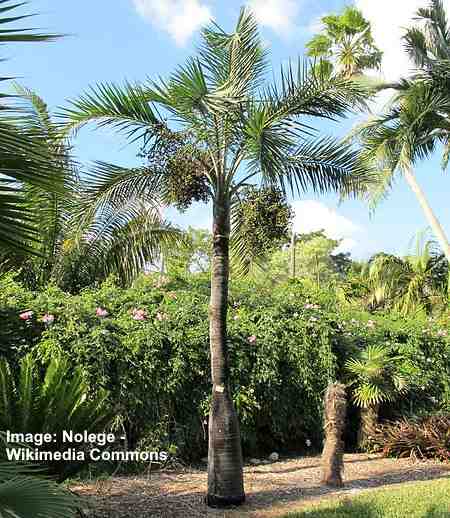
The Florida cherry palm is relatively small sized tree which is slow growing and cold sensitive
The Florida cherry palm is a sun-loving palm tree that is ideal for growing in coastal areas in the southeastern United States. Identifying features of the medium-sized palm are its arching, feather-like fronds 4 to 10 ft. (1.2 – 3 m) long, smooth, ringed trunk, and clusters of small yellowish flowers.
Florida cherry palm is suitable for growing in USDA zones 10 and 11. Its tolerance to salty air, intense sunshine, and drought makes it perfect as a specimen plant in tropical settings. The exotic palm tree grows 20 ft. (6 m) tall and has an arching crown up to 10 ft. (3 m) wide.
Pindo Palm (Butia capitata)
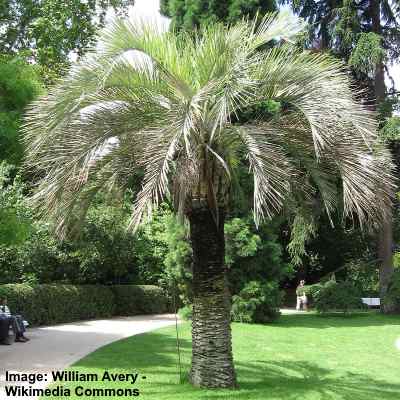
The small pindo palm tree is a slow growing and cold-hardy and is excellent for compact outdoor residential area in Florida
The pindo palm is an excellent choice if you’re looking for a small Florida cold hardy palm tree to grow in North Florida. The cold-hardy palm tree is a slow grower, reaching 15 to 20 ft. (4.5 – 6 m) tall. Its feathery pinnate blue-gray fronds measure up to 6 ft. (1.8) long and create a dense, bushy crown on the thick, stumpy trunk.
Both attractive and easy to care for, the pindo palm thrives throughout the Sunshine State—from Jacksonville in the north to Miami in the south. The palm is also called the jelly palm tree because of the edible fruits (pindo dates) with a pineapple or banana flavor that appear in summer.
Landscaping uses for the pindo palm include dressing up a coastal backyard and planting as a specimen tree or lawn tree.
Pygmy Date Palm (Phoenix roebelenii)
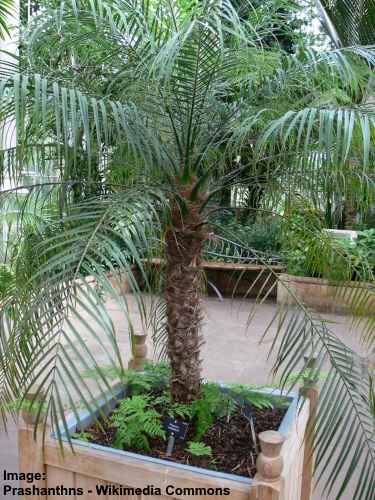
The pygmy date palm is a type of little palm tree with spiky trunk that is suitable for south Florida
Pygmy date palm is a compact, slow-growing palm tree that thrives in full sun. Usually, a single-stemmed palm, the tree can sometimes develop multiple trunks. The palm tree is identified by its slender, bumpy trunks, huge feather fronds with spiky petioles, and clusters of creamy-white flowers. The arching fronds create a crown of lush green leaves. The palm tree can grow up to 12 ft. (3.6 m) tall and 6 to 8 ft. (1.8 – 2.4 m) wide.
Pygmy date palm is an excellent landscape plant for small yards in southern Florida. You can also grow the palm tree in containers to add a tropical touch to your garden patio or deck area or to grace an entranceway.
Pygmy date palm is suitable for planting in USDA zones 10 and 11.
Windmill Palm (Trachycarpus fortunei)
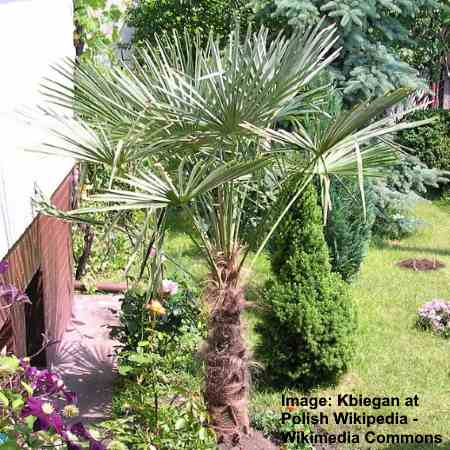
The windmill palm tree is cold hardy and slow growing small palm that can be grown in all parts of Florida
Windmill palm is a popular cold-hardy palm tree for growing in all regions of Florida. The tropical plant features large, fan-shaped fronds that grow up to 3 ft. (1 m) wide and a slender trunk covered in a fibrous, brownish-gray bark. In summer, clusters of yellow or white flowers appear, followed by bluish fruits.
The windmill palm tree typically grows up to 25 ft. (7.6 m) in residential landscapes. Its compact shape makes the subtropical palm ideal for planting in tight spaces that are partially shaded. You can plant the windmill palm as a specimen plant, accent plant, or in a group to create a tropical oasis in your yard.
Silver Saw Palmetto (Serenoa repens)
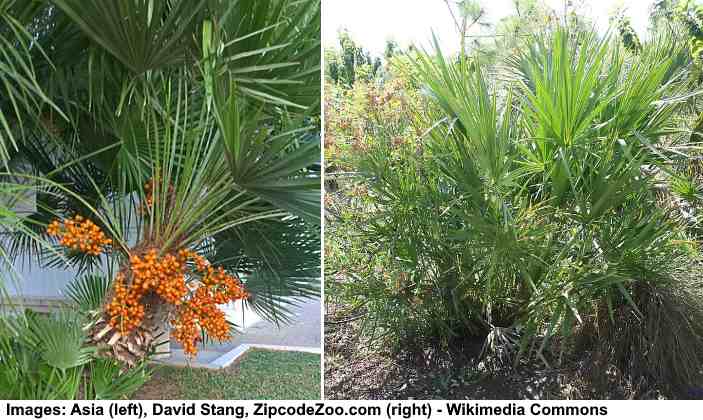
The small saw palmetto tree is native to Florida and is suitable for limited spaces and coastal areas
Silver saw palmetto is a native Florida palm tree with blueish-silver fan-shaped fronds. The clumping palm plant is a slow-growing shrub that grows 5 to 10 ft. (1.5 – 3 m) and 4 to 10 ft. (1.2 – 3 m) wide. Its palmate fan leaves are impressive, measuring up to 3 ft. (1 m) wide. The fronds grow on petioles covered in saw-like teeth.
The ornamental feature of this shrub-like palm is its silver-blue fronds, which grow in dense clusters. This growth habit makes it ideal for growing as a privacy hedge, screen, foundation planting, or hiding an ugly fence. Also, its salt tolerance makes silver saw palmetto an ideal plant for coastal gardens.
Silver saw palmetto is suitable for planting in USDA zones 8 through 11.
Dwarf Palmetto Palm (Sabal minor)
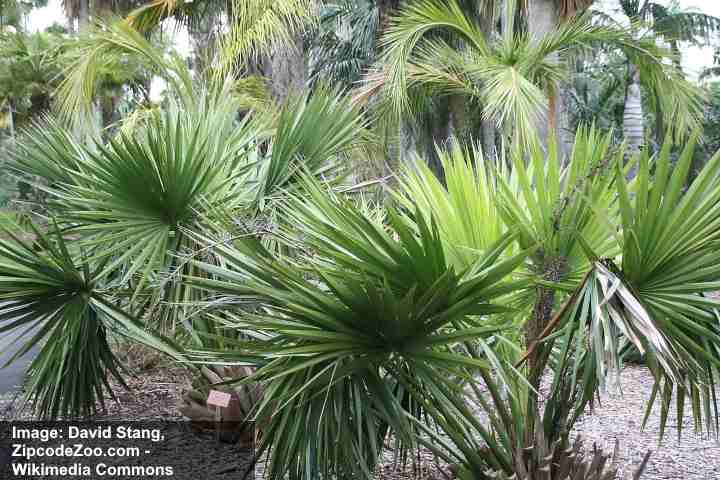
Dwarf palmetto can be found in many habitats and is a cold hardy small palm
The dwarf palmetto palm is a sun-loving, low-growing native palm tree perfect for Florida’s hot and humid climate. The cold hardy palm tree has blue-green fan-shaped leaves that grow up to 3 ft. (1 m) across, large clusters of creamy white flowers 6 ft. (1.8 m) long, and small, rounded black fruits.
The dwarf palmetto palm plant grows up to 4 to 6 ft. (1.2 – 1.8 m) tall and wide. It’s a sun-loving, salt and drought-tolerant trunkless evergreen palm, making it suitable for planting as a foundation plant for a textural accent in USDA zones 7 through 10.
Everglades Palm (Acoelorrhaphe wrightii)
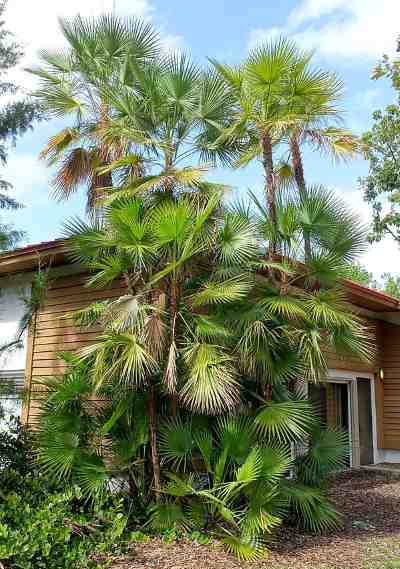
Paurotis palm is a small to medium sized tree with fanning fronds that grows in south Florida
The Everglades palm is a tropical sun-loving palm tree that thrives in the southernmost areas of Florida. The palm tree’s identifying features are its distinctive silver-blue color palmate fan fronds growing on arching stems on a slender trunk covered with fibrous matting. The fan fronds measure up to 6.5 ft. (2 m) wide.
As its name suggests, the Everglades palm is common in areas south of Fort Lauderdale. It typically grows 10 to 23 ft. (5 – 7 m) tall. The Everglades palm is ideal for creating a tropical look in southern gardens.
Arikury Palm (Syagrus schizophylla)

Arikury palm is a dwarf tree suitable for small gardens in south Florida
Arikury palm is a sun-loving tropical palm, ideal for growing in tight spaces. The multi-stemmed evergreen plant has large feathery fronds that grow 4 to 6 ft. (1.2 – 1.8 m) long. This drought-tolerant palm thrives in a variety of soil types and tolerates coastal, salty air.
The Arikury palm typically grows up to 16 ft. (5 m) tall. Its feathery foliage is perfect for creating a tropical landscape as a specimen plant or planted in groups to create an evergreen hedge.
The dwarf Arikury palm thrives in full sun in USDA zones 10 to 12.
European Fan Palm (Chamaerops humilis)
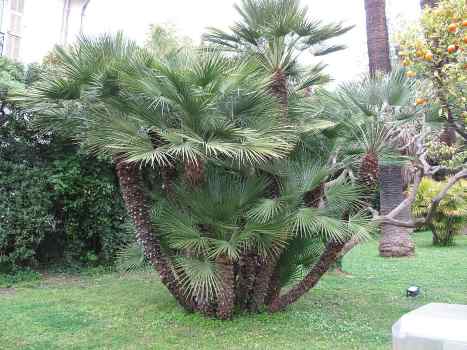
The European fan palm has few trunks and is small enough to suit many gardens
The European fan palm is a small, cold hardy, slow-growing, clumping palm tree perfect for sunny yards throughout Florida. This palm tree has fan-shaped, green, glossy fronds growing on short stems and creating a bushy form. The small palm grows 8 to 15 ft. (2.4 – 4.5 m) tall and up to 10 ft. (3 m) wide.
Suitable for USDA zones 8 through 11, the European fan palm is ideal for small, compact gardens. You can plant the European fan palm en masse as a privacy hedge or create an eye-catching sculptural element. In addition, the cold-hardy palm grows well in containers.
Chinese Fan Palm (Livistona chinensis)
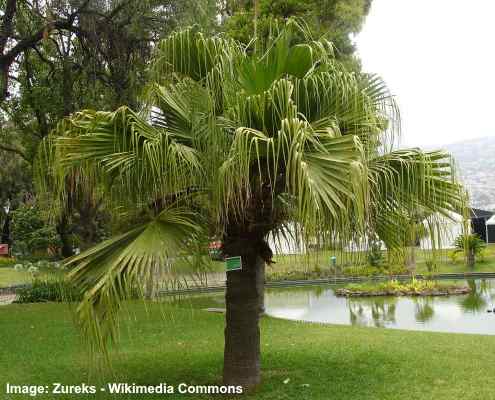
The ornamental Chinese fan palm is common in Florida and looks attractive in any landscape design
The Chinese fan palm is one of the most popular small palm trees in Florida landscapes. This tropical single-trunked palm tree has large, fan-shaped leaves that gracefully droop from the petioles creating a fountain-like effect. The palm tree grows up to 25 ft. (7.6 m) tall and 15 ft. (4.5 m) wide.
The Chinese palm tree is an attractive addition to any Central and South Florida garden. You can plant it as an accent tree, lawn tree, or in containers to create a tropical patio or deck area.
Spindle Palm (Hyophorbe verschaffeltii)
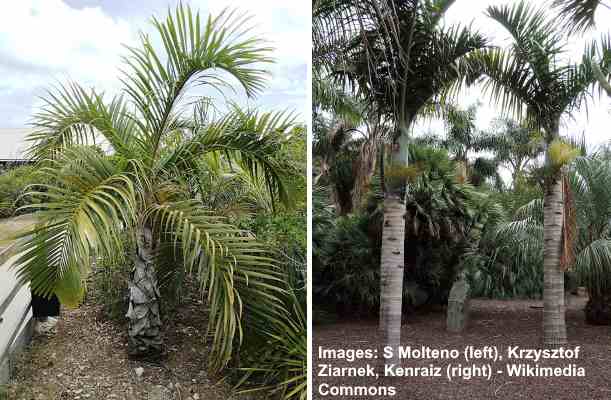
Young spindle palm (left) and mature tree (right)
The spindle palm is a small, slow-growing palm tree with a striking, slender trunk that bulges in the middle and a bright green crown shaft. The eye-catching smooth gray trunk is topped with a crown of feathery, bright green leaves that grow 6 to 10 ft. (1.8 – 3 m) long.
The spindle palm matures at 20 to 25 ft. (6 – 7.6 m) tall and 6 ft. (m) wide. You can grow the palm as a specimen plant in a sunny landscape or a large container on a patio or deck. Spindle palm is also suitable for planting in coastal areas, as it is highly tolerant of salt spray and wind.
Spindle palm is suitable for growing in USDA zones 10 and 11.
Madagascar Palm (Pachypodium lamerei)
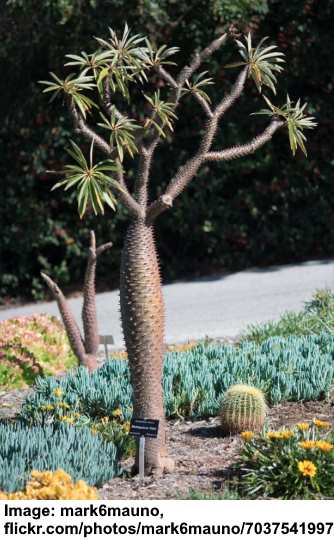
Madagascar palm is a small palm-like tree that can give a beautiful focal point to compact spaces
The Madagascar palm is a unique, exotic-looking plant with stunning white flowers, a spiny, bulging cylindrical trunk, and strap-like, glossy-green leaves. The palm’s flowers are saucer-shaped, pure white blooms measuring 4” (10 cm) across. The semi-deciduous tree grows 10 to 20 ft. (3 – 6 m) tall and 3 to 8 ft. (1 – 2.4 m) wide.
Although called a palm tree, the Madagascar palm is not a true palm in the family Arecaceae. Instead, it’s a succulent shrub or small tree. However, in mild-winter areas in Central and South Florida, the attractive plant adds a tropical touch to southern landscapes. In cooler climates, it grows well in containers and overwintered indoors.
Learn about the best palm trees to grow in Florida.
Related articles:
